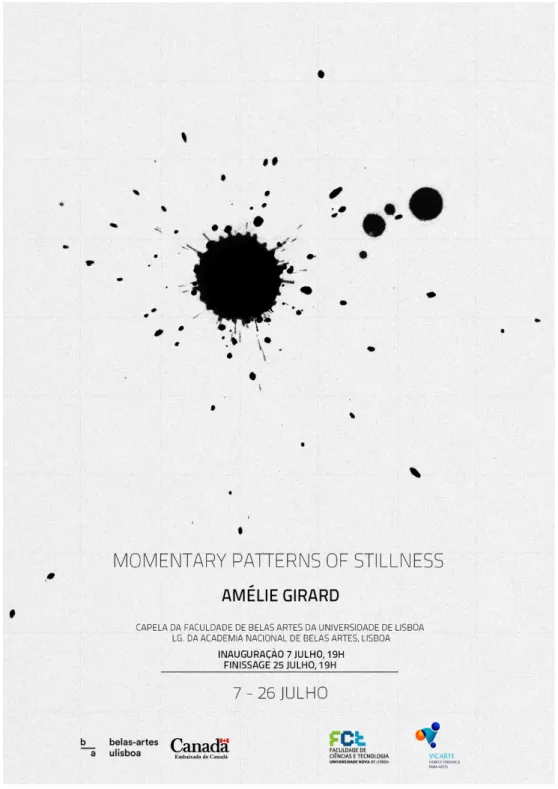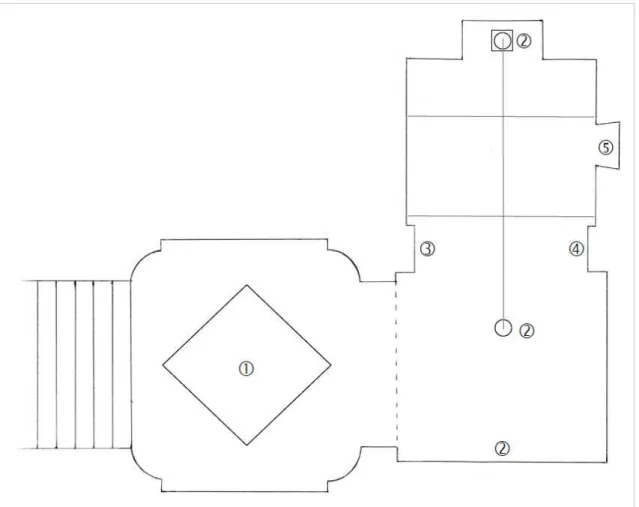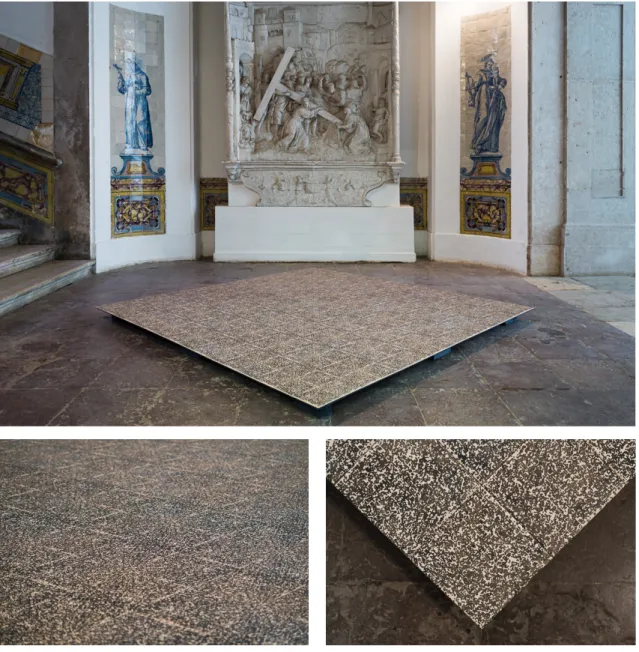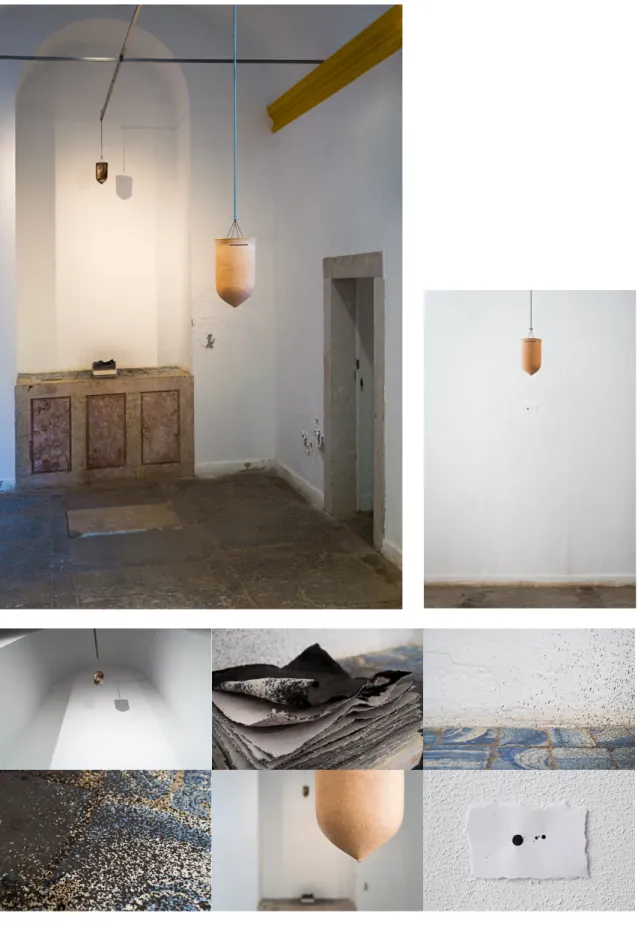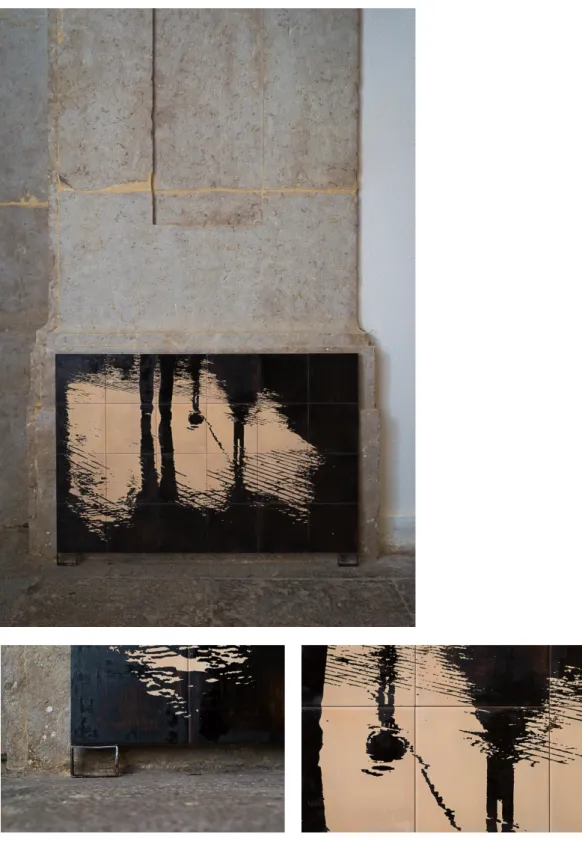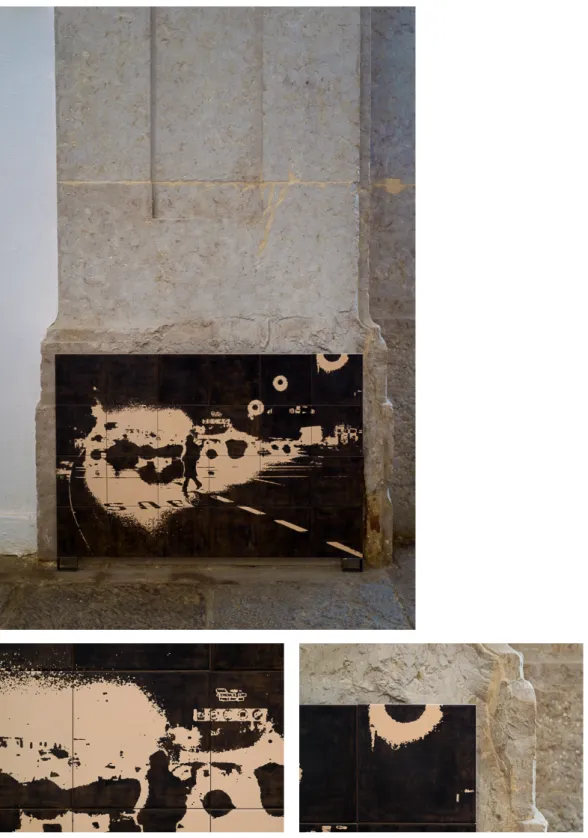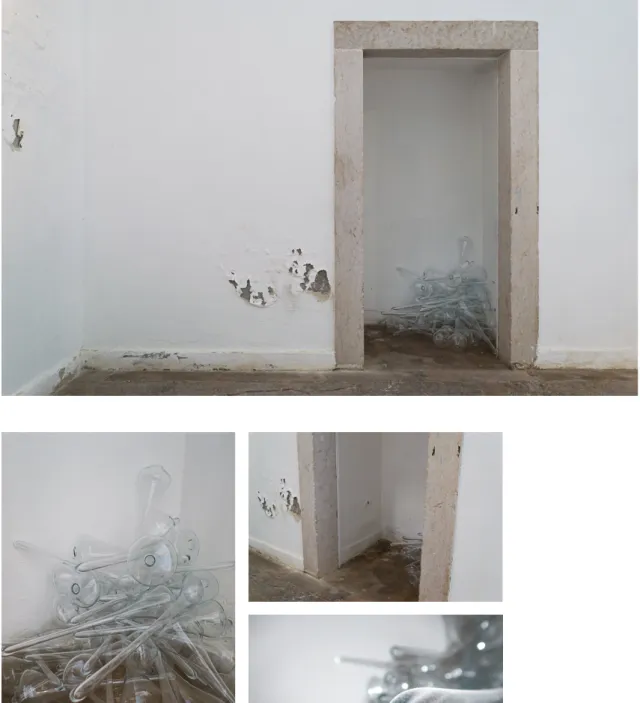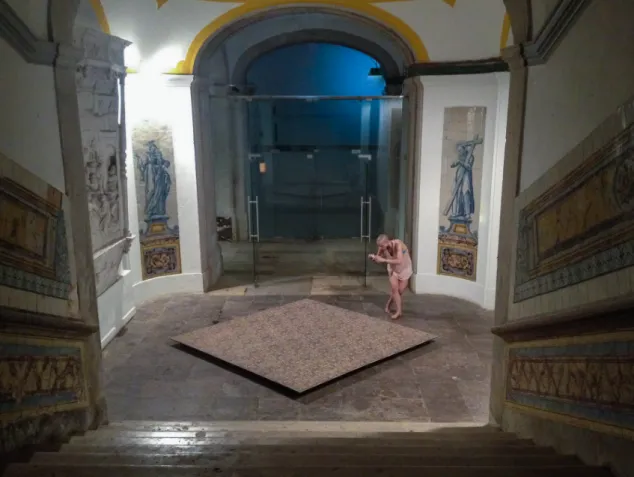Amélie Girard
Licenciatura em Matemática, Bacharelato em Artes Vidreiras
Beyond the Noise, Behind the Cotton Wool
Reflections on truth, silence, and the outward purposelessness of art
Dissertação para obtenção do Grau de Mestre em Arte e Ciência do Vidro
Orientadores: Doutor Richard Craig Meitner, Artista Convidado, Faculdade de
Ciências e Tecnologia, Universidade Nova de Lisboa
Professor Doutor Mário Jorge Pereira de Almeida Carvalho, Professor
Associado, Faculdade de Ciências Sociais e Humanas, Universidade
Nova de Lisboa
Júri:
Presidente: Professora Doutora Rita Andreia Silva Pinto de Macedo, Professora Auxiliar, Faculdade de Ciências e Tecnologia, Universidade Nova de Lisboa
Arguentes: Professor Doutor Sérgio Vicente Pereira da Silva, Professor Auxiliar, Faculdade de Belas Artes, Universidade de Lisboa;
Professor Doutor Paulo Alexandre Pinto dos Anjos da Silva Lima, Professor Auxiliar, Escola de Comunicação, Artes e Tecnologias de Informação, Universidade Lusófona do Porto
Vogais: Doutor Richard Craig Meitner;
Professor Doutor Mário Jorge Pereira de Almeida Carvalho
BEYOND THE NOISE, BEHIND THE COTTON WOOL
Reflections on truth, silence, and the outward purposelessness of art
Copyright © 2016 Amélie Girard
Faculdade de Ciências e Tecnologia Universidade Nova de Lisboa
Direitos de Cópia
A Faculdade de Ciências e Tecnologia e a Universidade Nova de Lisboa têm o direito, perpétuo e sem limites geográficos, de arquivar e publicar esta dissertação através de exemplares impressos reproduzidos em papel ou de forma digital, ou por qualquer outro meio conhecido ou que venha a ser inventado, e de a divulgar através de repositórios científicos e de admitir a sua cópia e distribuição com objectivos educacionais ou de investigação, não comerciais, desde que seja dado crédito ao autor e editor.
Copyright
ACKNOWLEDGMENTS
For someone who works chiefly (and proudly) alone, I find myself indebted to a surprisingly large number of people - institutions, professors, colleagues, family, friends, people who have supported and inspired me in a very significant way over the course of this Master's degree. I wish hereby to express my deepest gratitude to them as well as to all those whom, inevitably and unfortunately, I will omit, for lack of space or failure of memory.
To the Faculty of Science and Technology of Universidade Nova de Lisboa and to the members of the Research Unit VICARTE - Vidro e Cerâmica para as Artes for transforming my relationship to glass and propelling my work in a whole new direction.
To the Faculty of Fine Arts of Universidade de Lisboa for offering me such a rich and vibrant working environment, and to the Gabinete de Comunicação e Imagem for the opportunity to exhibit in the Faculty's beautiful historical chapel.
To the Embassy of Canada to Portugal for their financial support, and to His Excellency Jeffrey Marder Ambassador of Canada and Mr Eurico Nobre for their honourable presence at the opening of my graduate exhibition.
To my artistic supervisor, Doctor Richard Meitner, for his honesty, accuracy and guidance throughout this most challenging journey, and to my philosophy supervisor, Professor Jorge de Carvalho, for his exceptional insight, generosity and artistic sensitivity - and for leading me to Virginia Woolf.
To Robert Wiley, for pulling the hook out of my finger whenever it had to be done.
To Professor Regina Rodrigues for infecting me with her love of ceramics, and to Professors Pedro Fortuna, Fernando Quintas, Marta Castelo, Virgínia Fróis and Christopher Auretta for their remarkable openness and constant encouragements.
To José Martins for his priceless technical support, for the countless firings, and for holding the magnifying glass over the answer.
To Sérgio Bernardino for letting me transpose his wonderful photographs into tiles, for his unconditional help no matter how ridiculous the request and the time of day, and for everything that makes life in 4D.
To José Manuel Reis for his infinite kindness, calm presence and continued support, and to Camoles for all the hours spent masterfully orchestrating the lighting for my graduate exhibition.
To my classmates of the past two years for adding a much needed touch of colour and banter and chaos to my days, and in particular to Renato Japiassu for designing superb exhibition posters for me year after year.
To my past mentors Donald Robertson, Susan Edgerley and Michèle Lapointe, whose light still shines on me.
ABSTRACT
At age four, I used to secretly squeeze through the cracks in our backyard fence to go and
explore the world on the other side. One step at a time, a little further each time, those childhood
escapades soon grew into what would become the quest of a lifetime: a relentless and
passionate chase for "what lies beyond". Beyond the backyard fence, beyond sight, beyond the
human scope - a chase, one might say, for the true essence of the world. So I wandered and
wondered, from one country to the next and from mathematics to glass to art. A somewhat
winding journey I admit, yet one consistently marked by introspection and punctuated by
moments of unexpected stillness, of monumental silence. Could it be, I sometimes wonder, that
silence is the expression of the essence of the world?
It is with that question stirring at the back of my mind that I initiated my thesis work about a
year ago. The essence of the world, however, is not ours to touch, nor is pure silence ours to
experience; both forever elude human perception. Yet contemplating the horizon one can still
gather a sense of infinity. Hands anchored on matter, stretching my mind to philosophy and
literature, I thus attempted to expand my own horizons and achieve a broader understanding of
the kinship between truth, silence, and art.
The present thesis, alongside my recent artistic work, comes as a result of this
investigation. Combining my personal views with the ideas of various philosophers and artists,
and inspired in particular by the writings of Virginia Woolf, it explores the nature of art, the human
longing for being, and the tenuous threads of silence that span the gap between the two.
RESUMO
Aos quatro anos, tinha por hábito esgueirar-me secretamente através da cerca do nosso
quintal, para explorar o mundo que existia do outro lado. Um passo de cada vez, um pouco mais longe de cada vez, essas pequenas escapulidelas da infância acabaram por se tornar na procura de uma vida: uma inexorável e apaixonada busca por "aquilo que está além". Além da cerca do quintal, além do que é visível, além do alcance humano - uma busca, poderá dizer-se, pela
verdadeira essência do mundo. E foi assim que vagueei e tornei a vaguear e fui de espanto em espanto, de país em país e da matemática ao vidro - à arte. Um percurso, tem de se reconhecer, um tanto ou quanto sinuoso; no entanto, consistentemente marcado por introspeção e pontuado por momentos de inesperada quietude, de um silêncio monumental. Por vezes, penso: será que o silêncio expressa a essência do mundo?
Foi com essa pergunta em mente que iniciei o meu trabalho de tese, cerca de um ano atrás. No entanto, a essência do mundo não é algo que nos seja dado alcançar, nem tão pouco o silêncio puro é algo que possamos experimentar; ambos escapam inelutavelmente à perceção humana. Mas, ao contemplar o horizonte, sempre se pode imaginar o infinito. Então, com as
mãos ancoradas na matéria, alargando a minha mente à filosofia e à literatura, tentei expandir os meus horizontes e alcançar uma compreensão mais ampla da afinidade entre verdade, silêncio e arte.
Juntamente com o meu recente trabalho artístico, a presente tese surge como um produto desta investigação. Combinando o meu próprio ponto de vista com as ideias de vários filósofos e artistas, e inspirado em particular pelos escritos de Virginia Woolf, o texto explora a natureza da arte, o anseio humano peloser, e as ténues fibras de silêncio que atravessam a distância entre os dois.
TABLE OF CONTENTS
ACKNOWLEDGMENTS . . . . i
ABSTRACT . . . . ii
RESUMO . . . . iii
TABLE OF CONTENTS . . . . iv
TABLE OF FIGURES . . . . v
PART 1: ARIADNE'S THREAD . . . . 1
I . . . . 1
II . . . . 2
III . . . 3
PART 2: SILENCE AND ART . . . . 5
IV . . . 5
V . . . . 7
VI . . . 8
VII . . . . 10
VIII . . . . 12
PART 3: MOMENTARY PATTERNS OF STILLNESS . . . . 13
IX . . . 13
TABLE OF FIGURES
FIGURE 1 - Poster for the exhibition Momentary Patterns of Stillness . . . . 15
FIGURE 2 - Plan of the exhibition . . . . 16
FIGURE 3 - Still . . . . 17
FIGURE 4 - All That There Was, All That's to Be . . . 18
FIGURE 5 - September . . . . 19
FIGURE 6 - January . . . . . 20
FIGURE 7 - Someday . . . . . 21
PART 1: ARIADNE'S THREAD
"Life's what you see in people's eyes; life's what they learn, and,
having learnt it, never, though they seek to hide it, cease to be aware of."
- Virginia Woolf, An Unwritten Novel1
Ι
Where does one start writing a thesis? So much has happened that I do not yet
understand. My own artwork stands before me and I barely recognize it. Blurred, fragmentary
memories whirl around my head as I try to put the pieces back together - remnants of pain and
frustration, of bliss and self-doubt, echoes of tiles clinking, calloused fingers, a scar on my right
shoulder. Traces of process. But the wheel keeps on turning, minutes vanish before we have
time to reflect upon them, then hours, days, years, leaving nothing but scarce crumbs for us to
draw answers from. At best there is time to feel, to intuit; but understanding is a rare luxury.
How, then, does one escape the daze and start making sense of it all? Perhaps if I follow my
own trail of crumbs and go back to where it all began, I shall get a clearer sense of direction.
...
I am four years old, playing outside my house on a summer day. Secretly, without my parents
noticing, I squeeze through the cracks in the backyard fence - I have been dying to see what is on
the other side. My steps do not take me very far before my parents find me. But it is too late: the
immensity, the beauty, the complexity of the world have struck me. The horizon now stretches
into infinity, now and forever.
I am 19 years old, pursuing a degree in pure mathematics. Halfway through a logic exam I stare
perplexedly at the last question - an unusual question indeed as we are asked, not for the
customary mathematical proof, but to explain something in our own words. I hazard an answer.
The words come out hesitantly at first, then faster, and faster still, until I feel almost possessed: I
understand. A breach has opened to the depths of the world, poetry is pouring out, suffusing me
whole. All is one.
1
I am 28 years old, living in Japan. I enter the lobby of the school where I teach. Five days a
week I enter that same lobby where I am required to take off my outdoor shoes; it is a familiar
place. On the wall to my right is a small alcove where one of the office ladies places a new flower
arrangement every week. Ikebana2. It is always beautiful, but today it is different: today it is
sublime. It stops me in my tracks - the whole world, it seems, stops in its tracks. I feel a
monumental stillness. Some sort of profound truth is at work, something akin to perfection.
Everything is in its right place.
...
All this might seem incongruous; it is not. We must simply delve a little deeper now so we
can seize the Ariadne's thread, and then unravel it, as best we can.
ΙΙ
The three episodes described above are of great simplicity - I was, after all, just playing
outside, just answering a question, just taking off my shoes. Yet to me they were phenomenal,
for in each of those moments I felt a sudden, profound, complete connection with the world that
forever changed my outlook on it. They were moments of awe and understanding - what Virginia
Woolf, in her late writings, calls "moments of being" or "moments of vision".3 Everyday life, for
Virginia Woolf, includes much morenon-being thanbeing, as if everything were "embedded in a
kind of nondescript cotton wool"4:
A great part of every day is not lived consciously. One walks, eats, sees things, deals with what has to be
done; the broken vacuum cleaner; ordering dinner; writing orders to Mabel; washing; cooking dinner; bookbinding. [...] As a child then, my days, just as they do now, contained a large proportion of this cotton
wool, this non-being. Week after week passed at St-Ives and nothing made any dint. Then, for no reason
that I know about, there was a sudden violent shock; something happened so violently that I have remembered it all my life.5
We all, I believe, experience (however rarely) moments like this, moments of such
unexpected and sudden intensity that they seem to detach themselves from the flow of life yet at
the same time to encompass life in all its entirety, fleetingly revealing, to paraphrase Virginia
Woolf, the hidden pattern behind the cotton wool.6 There is a spark; a flame; suddenly everything
is lit up, bright and clear; we glimpse at the hidden pattern. Violently we are hit by an "avalanche
2
Japanese for "art of flower arrangement".
3
Woolf, 1939/1985, pp.73, 78. See also: Silva, 2011, pp.290-299.
4
Op.cit., p.70.
5
Op.cit., pp.70-71.
6
of meaning"7 - an exacerbated sense of "life itself"8, life as it truly is, undistorted, unhindered,
infinite. For but an instant all is one. Soon the flame dies, but its glaring silhouette lingers on the
retina of our mind. Moments of being live on in our memories, indelible, irreversibly associated
with the objects that triggered them - theiremblem, typically objects of great banality, not at all
seen for the first time but certainly seen anew.9 A front street; a math exam; a flower
arrangement. For each moment of being an emblem - the wick that held the flame.10
I encountered my first conscious moment of being at age four; I have spent the rest of my
life chasing the hidden pattern. To touch the essence of the world,life itself - such has been my
quest, through childhood, through mathematics, through travelling, through art-making, through
this Master's degree. My leitmotif.
III
I have, of course, never touched the essence of the world - it is not ours to reach. Yet
gazing at the horizon one can still gather a sense of infinity. Aware though I may be of my
corporeal limitations, mind anchored to body and feet anchored to the ground, I have long
pondered the confines of the human experience, the hazy frontier between our sensory
capabilities and the real world beyond. That is by no means unexplored ground: Plato already, in
hisPhaedo, hints at a similar inquiry. "Then when does the soul attain to truth? For when it tries
to consider anything in company with the body, it is evidently deceived by it."11 (And I must say, it
is heartening to share a questioning with Plato.) What is more, the word body in Plato's writings
does not simply denote the physical body; rather, it alludes to a whole integrative perspective.12 It
is the habitual, passive, unquestioning standpoint of everyday life - it is non-being. Soul, in turn,
refers to the viewpoint of the aware mind, that which is in a state ofbeing, stretching out from the
body towardtruth - toward the hidden pattern.13 Toward, but neverto. For the soul stands in
limbo between body and truth, its ties with the former keeping the latter out of reach, much in the
same way thatbeing is a personal experience of the truth and not the truth itself. We may briefly
glimpse at the hidden pattern but we can never see it whole. Truth as such lies altogether
beyond the human scope, in a place sheltered from interference and commotion and noise - a
place bathed in silence. And indeed every time I have experienced a moment of being, it has
7
Op.cit., p.78.
8
Character in Fiction. In: Woolf, 1924/1994b, p.436. See also: Silva, 2011, pp.89, 93, 94 et passim.
9
Silva, 2011, pp.299-315.
10
Op.cit., pp.72, 300, 305 et passim. Silva's formulation here paraphrases Hugo von Hoffmanstahl: "Das geliebte Wesen ist immer nur der Docht in der Liebesflamme" (The loved one is always only the wick in the flame of love). Cf. Hoffmanstahl, 1973, p.85.
11
Plato, trans. 1953, p.227.
12
On this topic, see notably: Carvalho et al., in press.
13
This idea of the double perspective of body and soul was also beautifully expressed by Friedrich Hebbel when he wrote: "Der Mensch ist ein Blinder, der vom Sehen träumt" - a phrase which, due to the nature of the German language, remains ambiguous. It means bothMan is blind and merely believes that he sees, and
been accompanied by a profound, extraordinary silence, as if the din of everyday life had been
altogether stilled. Could it be, I sometimes wonder, that silence is the expression of the essence
of the world?
Certainly I have encountered several different forms of silence - and perhaps even more
different forms of noise - over the course of my life; some more specific to childhood, others to
nature, others still to art, to Japan, to love, to loss, to loneliness, and so on . But nothing, to this
day, has bestowed greater silence upon me than mathematics. (Here I must insist: mathematics,
not arithmetic. The two are often mistaken for one another. Yet they differ in the same way that
grammar differs from literature.) Mathematics are immaterial by nature, intangible, imperturbable;
they are a construct of the mind, supported by the physical world yet disconnected from it. They
are made for the most part of sharp lines and clear-cut answers, black or white, true or false. A
form of perfection, a haven for the soul, cut off from the perpetual chaos and uncertainty of our
worldly reality. Tremendous poetry resounds within the seemingly austere silence of
mathematics - a poetry soothing and bright which (as poetry does) bypasses reason to reach out
directly to the soul, making emotions vibrate like sympathetic strings.14 The kind of poetry, one
might say, that makes mathematicians resolve to become artists.
I cannot stress enough the importance that mathematics have had, and continue to have,
on my artistic practice - in terms of favoured aesthetics, undeniably, but first and foremost in
terms of process and approach. Art is arguably the most intrinsically human of all human
endeavours, and as such it is fundamentally unfathomable; each artist is compelled by something
different, something uniquely personal. To me art-making is a manifold attempt to draw the
poetry that I have experienced through mathematics into the material world - to induce sublime
truth through simple flower arrangements. I do not make art to express ideas, expel emotions or
uncover my deepest self, no; although over time these often emerge as the most remarkable and
rewarding facets of art-making, they are incidental, not the underlying motivation. The truth is, I
make art to find peace - to find refuge. To revisit again and ag ain that serene, secluded place
removed from the daily pain of human life that mathematics first took me to. It is an elusive goal,
I do not know the exact way to it, nor do I believe that there exists such a way; but I wander,
following no particular straight line, observing, making, reflecting, gathering fragments of being as
I go along, leaving markers for myself in their stead, markers made of glass or clay, of rough
outlines and scribbled notes. From beginning to end, throughout the creative process and in the
resulting work, relentlessly pursuing silence. The expression of the essence of the world.
14
PART 2: SILENCE AND ART
"There is a silence in life, a perpetual deposit of experience for which action
provides no proper outlet and our own words no fit expression."
- Virginia Woolf, Byron and Mr. Briggs15
IV
As compelling a pursuit as it may be, drawing the evanescent poetry of the world into a
material object remains an enigmatic task, and one which indeed continues to confound me. I do
not know if I have ever succeeded, nor if or to what extent I ever will - a maker is far too intimate
with his or her own work to ever be able to see it for what it is. That is, perhaps, the greatest
paradox of art-making: that the artist should know so much about the making process that the
finished piece as a self-contained entity should forever elude him, while the viewer finds himself
precisely in the opposite position.16 Only through the endeavour of the artist does the work gain
substance, only through the experience of the viewer does it gain meaning; where (if anywhere)
both converge is where art is allowed to take place. Art is thus, by nature, symbolic.
Symbolic here is to be understood in the sense put forth by Friedrich Schelling in his
Philosophy of Art. Human imagination, Schelling suggests, fosters three modes of
representation: schematism, allegory, and the symbolic.17 Schematism is the representation of
the particular through the universal, allegory the representation of the universal through the
particular.18 Language, for instance, schematizes while arithmetic allegorizes.19 The symbolic is
the synthesis of the two, "where neither the universal means the particular nor the particular the
universal, but rather where both are absolutely one"20. Simultaneously self-inclusive and
all-inclusive, the symbolic brings about a sort of inversion, a paradox, as it shifts from merely existing
within its surroundings to casting its light upon them, embracing them, making them whole. "Both
are absolutely one". The symbolic then is not simply in relation with the whole, it does not simply
evoke the whole - itis the whole. Being. A glimpse at the hidden pattern. Partial always, but a
whole in and of itself.21
15
In: Woolf, 1922/1994b, p.497.
16
The word "viewer" here is inadequate, but will be used onwards to alleviate the text. It implicitly includes readers, listeners, spectators and so on - anybody other than the artist himself who is brought in contact with the artwork. Similarly, the generic masculine form will be used from now on.
17
Schelling, 1859/1989, p.46.
18
Ibid.
19
Op.cit., pp.46, 48.
20
21
The symbolic thus walks the fine line between schematism and allegory - between
existential integrity and meaning. This places art in precarious balance. On the one hand, we
naturally long for meaning - for a manifestation oflife itself through some personal connection
with the artwork, either emotional, physical or intellectual. (For it would be naive to presume that
the connection can only be, or must be, purely emotional; there are various gateways to the soul.)
Yet as soon as we ascribe specific meaning to an object it ceases to exist solely for what it is.
Schelling explains:
As soon as we allow these beings tomean orsignify something, they themselves are no longeranything.
[...] I emphasize that we are not satisfied with meremeaningless being, such as that given by a mere
image. Just as little are we satisfied with mere meaning. Rather, whatever is to be the object of absolute
artistic representation should be as concrete and self-identical as the image, and yet as universal and
significant as the concept. [...] The delight comes precisely when we simultaneously recognize the
significant or meaningful element contained within this unintentional, unaffected, and outwardly purposeless
existence.22
Recognizing the outwardly purposeless existence of the artwork is to acknowledge the
value of its sheer existence - for perhaps to exist, simply and self-containedly,is the purpose of
the work. Martin Heidegger, in his Origin of the Work of Art, puts it beautifully when he says:
What, however, is more commonplace than that a being is? In the [art]work, on the other hand, the fact that
i tis as such a thing, is what is unusual. The happening of its createdness does not simply reverberate
through the work; rather, the work casts before itself the eventful fact that, as a work, this work is, and
exhibits this fact constantly. The more essentially the work opens itself, the more luminous becomes the
uniqueness of the fact that it is rather than is not.23
If we approach the artwork as symbolic - that is, if we recognize its outward
purposelessness and its self-contained purposefulness, if we recognize its silence - then we can
start to wonder at its very existence and be touched by its truth. "Thus when the moment of
illumination comes we accept it implicitly. We are neither roused nor puzzled; we do not have to
ask ourselves, What does this mean? We feel simply that the thing we are looking at is lit up, and
its depths revealed. It has not ceased to be itself by becoming something else."24
21
Schelling's symbolic has that particularity of all-inclusiveness that is indeed reminiscent of Virginia Woolf's moments of being. In a context ofnon-being, the object simply stands for itself. In the case of schematism and allegory, the object stands for something else, something either more general or more particular. But the symbolic does not merely stand for something else - it isone with something else, and indeed with everything else. It stands for life itself.
22
Op.cit., p.49.
23
Heidegger, 1950/2002, p.40.
24
V
Oftentimes however, one has the feeling that modern thinking has done great violence to
the symbolic value of art, "as if the modern mind, wishing always to verify its emotions, had lost
the power of accepting anything simply for what it is".25 Contemporary art, subject to that trend,
has been growing increasingly conceptual; it is becoming lopsidedly and clumsily allegorical as
we struggle more and more to embrace artworks for their sheer existence. Interpretations prevail,
often to the detriment of truemeaning. As Susan Sontag wrote in herAesthetics of Silence:
"practiced in a world furnished with second-hand perceptions, and specifically confounded by the
treachery of words, the activity of the artist is cursed with mediacy".26 The fresh outlook of the
viewers is blurred from the get-go by their desire to understand, or rather, by their conviction that
there is something to understand; spontaneously they turn to the artist for an explanation.
But meaning, as discussed earlier, lies between the viewer and the work, it is beyond the
reach and power of the maker. The scope of the artist begins and ends with process - I do not
know what I have created, I only know what I have done. The finished piece is stand-alone,
independent, whole, and as such it encompasses a parcel of reality that no worded description
can ever fully capture, no matter how carefully crafted. "Where so much strength is being spent
on finding a way of telling the truth the truth itself is bound to reach us in rather an exhausted and
chaotic condition."27 This, of course, is not unique to artworks; the human experience as a whole
vastly eludes language. To quote Ludwig Wittgenstein: "What finds its reflection in language,
language cannot represent. What expressesitself in language,we cannot express by means of
language".28 However it is my feeling that the essence of artworks rests precisely in those infin ite
nooks and crannies where words cannot reach, where silence prevails. Interpretations are thus
reductive and deleterious to the integrity of the artwork, detracting from its intrinsic qualities and
adding a layer of noise through which the work no longer breathes, the poetry is no longer heard.
"Whereof one cannot speak, thereof one must be silent."29
Avoiding the temptation of words and linear explanations then, allowing himself full freedom
of emotion and imagination and embracing the work first and foremost for what it is, the viewer
can openly approach the artwork. It follows naturally that, should meaning arise from the
encounter, it should not be expected to come to the viewer in the form of a clear idea or a
well-structured paragraph, but rather as an elusive inner vibration - as amoment of being of which the
25
Poetry, Fiction and the Future. In: Woolf, 1927/1994a, p.433.
26
Sontag, 1969, p.5.
27
Character in Fiction. In: Woolf, 1924/1994b, p.516.
28
TLP 4.121. In: Wittgenstein, 1921/2001, p.31.
29
artwork is but the trigger. If, why and how the work will propel the viewer into being is
unforeseeable; meaning is fundamentally personal and circumstantial, and widely transcends the
artwork. "Then it is not the actual sight or sound itself that matters, but the reverberations that it
makes as it travels through our minds. These are often to be found far away, strangely
transformed; but it is only by gathering up and putting together these echoes and fragments that
we arrive at the true nature of our experience."30 For meaning to arise,something within the
artwork must resound withsomething that pertains to the viewer's own personal experience,
neither of which can be anticipated. A most serendipitous happenstance indeed, hence perhaps
its beauty, its truth.
VI
But what, then, is the role of the artist? If meaning is in the hands of the viewer, if thus it
cannot be predetermined or embedded into the work, is the artist, then, a mere maker of queer
things? Are all those queer things equally potent, equally able to touch the audience regardless
of their form? If, as pointed out earlier, moments of being (and thereby meaning) can be sparked
even by the most banal everyday objects, does art actually serve a distinct purpose? And if so,
what is that purpose?
As these questions arise, we find ourselves thrust from the relatively removed standpoint of
the viewer into the realm of the artist - the obscure side of the artwork. Here we must pause and
remind ourselves that art, as noted before, is a fundamentally human and therefore unfathomable
endeavour; only in vain could we attempt to speak for all artists at once. One can speak but from
a personal perspective. Sometimes however, one has the feeling that one's own experience
carries fragments of infinity. Perhaps the only way to find insight into the greater truths of art is to
delve into one's own artistic practice. Tomake art. Nothing seems more simple; nothing is more
daunting.
To begin with, the utterly intricate nature of the relationship between an artist and his work
can be baffling. In the words of Heidegger:
The artist is the origin of the work. The work is the origin of the artist. Neither is without the other.
Nonetheless neither is the sole support of the other. Artist and workare each, in themselves and in their
reciprocal relation, on account of a third thing, which is prior to both; on account, that is, of that from which
both artist and artwork take their names, on account of art.31
30
Impassioned Prose. In: Woolf, 1926/1994a, p.367.
31
Art, artist and artwork are closely interwoven, artist and artwork serving to give substance
to the otherwise immaterial fabric of art. Within that fabric too, artist and artwork are intertwined.
Art-making is what makes artists artists; otherwise they are simply people. It is thus the artwork
that gives birth to the artist, who himself gave birth to the artwork in the first place. They bear the
seeds, life and faults of one another - hence the introspective, part painful, part blissful nature of
art-making. But the interdependence between artist and artwork is not paradoxical as much as it
is circular, and I intuit that this circularity is what gives art its very impetus. There is no beginning,
no end; only an ineluctable, perpetual motion.
The artist thus finds himself in a curious position regarding his own work, a position both
privileged and nearsighted. I have discussed earlier the fact that the artist, being the creator of
the work, is too intimate with the details of its making to ever be able to see it with completely
fresh eyes. But this is not to say that the artist is alien to his work - quite the contrary. In fact
every single detail of the making process, that is, every single decision made by the artist along
the way, is a defining moment in the birth of the artwork. The work speaks of its maker in ways
that nobody, not even the maker himself, can fully grasp. "In each picture is a whole lifetime
imprisoned, a whole lifetime of fears, doubts, hopes, and joys. Whither is this lifetime tending?
What is the message of the competent artist?"32 Such is the privilege of the artist: to
unintentionally yet continuously crystallize infinite fragments of his life and soul into his work so
that he may - sporadically, unexpectedly - catch glimpses of himself, and over time achieve a
clearer sense of purpose and direction. His struggle is his reward, his work an outer (though
somewhat encrypted) expression of an otherwise veiled inner truth - his self.
One might argue, of course, that the same holds true of all human activity, whether artistic
or not. "Somewhere, everywhere, now hidden, now apparent in whatever is written down is the
form of a human being."33 Indeed everything we do reveals, one way or another, our deepest
individual nature. Yet art-making sets itself apart by the peculiar fact that, unlike other
endeavours, it serves no direct outer purpose, no distinct end. Let us look back on Virginia
Woolf's portrayal of non-being, for instance: "one walks, eats, sees things, deals with what has to
be done; the broken vacuum cleaner; ordering dinner; writing orders to Mabel; washing; cooking
dinner; bookbinding". All those activities are conducted with a clear outcome in mind - the cotton
wool provides outer purpose aplenty. The higher pursuits of the human mind too, such as
science, philosophy or contemplation, are carried toward an external object. Art-making, by
contrast, is of a perplexingly introverted nature. We have already discussed the self-contained,
outwardly purposeless existence of the artwork; correspondingly art-making is a self-contained,
outwardly purposeless process. The purpose of art-making rests entirely within the process itself
- it is not to create artworks as much as to make art.
32
Kandinsky, 1911/1977, p.3.
33
How purpose arises, how it is felt, I presume, is unique to each artist. For me it is
something akin to the poetry of mathematics: a reflective pool, a profound peace, a silence, a joy
too, and a faint but intoxicating sense of perfection. (And I do feel sorry for those, numerous, who
feel no affinity for mathematics.) Still and all, regardless of its fluidity of form, the experience of
purpose in art-making (hereafter referred to simply aspurpose), I believe, is common to all artists,
and in the same way that meaning lies entirely between the viewer and the artwork, purpose lies
entirely between the artist and his making.
The difference is subtle but fundamental. Meaning arises from artworks much in the same
way it does from other objects (though perhaps not with the same likelihood as common objects
are usually approached with more indifference, artworks with more awareness)34, that is, in a
dispersed and discontinuous fashion, each instance differing from the next. Purpose on the other
hand, while of equally unpredictable occurrence, seems to me a much more consistent
experience, drawing the artist always to the same place, to the same deeply hidden inner spring,
each time dissipating the mist around it a little more. Uniquely personal and equivocal though it
may be, purpose is inherent to art-making, and I hazard that purpose is in fact what differentiates
artworks from other man-made objects - that purpose holds the seeds ofart. In any event this
concurs with my own experience, as the work in the making of which I find more purpose appears
to also better resonate with the viewers. And I go on to suppose that purpose, to a degree,
translates into the work and fosters meaning. That is not to say, however, that purpose should
prevail over meaning. As much as they may diverge, purpose and meaning are equally
important, equally valid, for they both emerge from the cotton wool of everyday life. They are
both forms of being.
VII
Be that as it may, we must be careful not to fall for what Susan Sontag describes as the
leading myth about art: that of the absoluteness of the artist’s activity.35 Indeed despite their
artistic intent, artworks are still objects and artists are still human; neither is the bearer of a
superior, godlike truth. Art-making is not a continuous outpour of inspiration as much as a
perpetual decision-making process, inevitably influenced by the context and limitations of the
moment. "Whatever way a work of art is, it could have been - could be - different. The necessity
ofthese parts in this order is never given; it is conferred."36 This is perhaps most pressingly true
34
To this I would add that no form of meaning is exclusive to artworks - art is part of the broader experience of everyday life and not the other way around. Art can echo life but cannot transcend it. It is, in fact, for that reason that art resounds with us the way it does: because it is made of the same stuff as everyday life and thus corresponds to our own personal experience of everyday life, whatever that experience may be.
35
Sontag, 1969, p.4.
36
during the final stage of the art-making process, namely the exhibition. For an exhibition is not,
despite what it may seem, a mere outgrowth of the art-making process; it is a significant part of it.
The particulars of the exhibition impose a certain set of constraints upon the artist (temporal,
spatial, technical, financial, etc.), forcing him - and it does require tremendous force - to narrow
the infinite range of all that the work could have been down to one single final form. "But why
impose my arbitrary design? Why stress this and shape that and twist up little figures like the toys
men sell in trays in the street? Why select this, out of all that - one detail?"37 With every
exhibition a new set of constraints, a new final form, each exhibition creating its own specific
context for the work to exist in and interact with, hence impacting the way the work is perceived
-and indeed the same body of work placed in a different context automatically finds itself altered.
The exhibition is for the artist a phase of practical decisions and self-conflicting compromises,
often nerve-racking in contrast with the quietude and freedom of the prior making phase. The
former is prose, the latter poetry, art-making an attempt at "connecting the prose and poetry of
life"38.
Too often, we - artists, viewers - disregard the presence of prose within the artwork; yet it is
what most reveals the human being behind it. "The poet gives us his essence, but prose takes
the mould of the body and mind entire."39 Besides purpose and inspiration are a multitude of
pragmatic, contextual, necessary choices that speak of the artist's character and intellect as
much as it does his sensibility and vision. Prose may lack the mystery of poetry but it is no less
evocative; each has a voice, each tells a story, poetry more ethereal, prose closer to the physical
world and the artist himself. The challenge of art-making lies, not in silencing the prose, but in
letting its voice - its rugged, mundane voice - carry that of poetry. Some compromise is
inevitable; but humanity and imperfection are intrinsic, perhaps even essential, to artworks. And
as Virginia Woolf insightfully points out: "the success of the masterpieces seems to lie not so
much in their freedom from faults - indeed we tolerate the grossest errors in them all - but in the
immense persuasiveness of a mind which has completely mastered its perspective".40
37
Woolf, 1931/1980, p.134.
38
The Novels of E.M. Forster. In: Woolf, 1927/1994a, p.497.
39
Reading. In: Woolf, 1919/1994b, p.157.
40
VIII
For artists and viewers alike, the experience of art is a most peculiar one: outwardly
purposeless, unpredictable, serendipitous and deeply personal all at the same time. Its power
lies in its very complexity, so reminiscent of human nature, so evocative of ourselves, so
propitious to self-reflection. "But when the self speaks to the self, who is speaking?"41 That is,
perhaps, the question which art most persistently asks: Who is speaking? All of my selves, it
seems, are speaking at the same time. My four-year-old self by the backyard fence; my
nineteen-year-old self taking a math exam; my twenty-eight-year-old self marvelling at a flower
arrangement; and all my other selves too, the one who was raised in the snows of Canada, the
one who travels compulsively, the one who blows glass, the little girl, the grown-up woman - all
those selves that have experiencedbeing and shaped my vision of the world. Their voices echo
with mine; yet they are not mine. My true voice is of a different nature: my true voice belongs to
life itself. But who is speaking? As I delve deeper and deeper into the intimacy of my art-making,
trying, in vain - for it can only be in vain - to answer that question, I patiently sift through the
voices of my different selves as one would pan sand for gold: seeking the minuscule pearls of
silence that I share with the essence of the world.
41
PART 3: MOMENTARY PATTERNS OF STILLNESS
"I have made up thousands of stories; I have filled innumerable notebooks with phrases to
be used when I have found the true story, the one story to which all these phrases refer.
But I have never yet found that story. And I begin to ask, Are there stories?"
Virginia Woolf, The Waves42
IX
That truth shall forever elude us; that art is by nature symbolic thus without an outer
purpose; that meaning is out of the hands of the artist; that an artwork removed from its exhibition
setting is no longer the same artwork; that interpretations are detractive; that words can never
capture the entire scope of an artwork; that silence is key; it is with all these thoughts stirring at
the back of my mind that I must now, somewhat paradoxically, attempt to introduce my work, and
in particular my graduate work exhibited last July at the Faculty of Fine Arts of the Universidade
de Lisboa under the titleMomentary Patterns of Stillness. A certain economy of words, therefore,
seems appropriate - even necessary. Besides, we must reflect that perhaps we already know
enough. After all, the aforementioned thoughts arose during the making of the work; they are
entwined with the multitude of events that led to the exhibition, entwined with all my different
selves and with my vision of the world; together they form the warp and woof of the work. As for
the rest, may the work speak for itself. Let us avoid gagging it with explanations and practical
details; some personal thoughts and impressions at most, and some pictures, shall suffice. The
result, necessarily, will be an incomplete rendering, but thereby perhaps more intact, more alive
-more likely to reach out to the viewer's own individual sensitivity and imagination, and to yield
meaning.
42
X
Looking for silence I waltzed with noise, round and round, aimlessly, endlessly.
One two three one two three one two three one two three.
I walked out in the rain, in the cold, my hands stuffed in my pockets, looking down, looking up,
looking in, looking out, counting my footsteps.
One, two, three, one, two, three.
I crushed words to nihility, turned their carcasses into a blank canvas, dispersed the black sap of
their distilled soul into millions of anonymous speckles.
O n e t w o
t h r e e o n e
t w o t h r e e
o n e t w o
t h r e e .
I stood still, contemplating the drops of time forming, stretching, falling; forming, stretching, falling;
drop after drop gently crashing down, shattering in their fall their fragment of infinity.
One.
Two.
Three.
One.
Tw - ?
FIGURE 1 - Poster for the exhibition Momentary Patterns of Stillness
FIGURE 2 - Plan of the exhibition Still (see Figure 3)
All That There Was, All That's to Be (see Figure 4)
September (see Figure 5)
January (see Figure 6)
FIGURE 3 - Still
Hand glazed and laser engraved ceramic tiles 10x240x240 cm
FIGURE 4 - All That There Was, All That's to Be
Stoneware, water, India ink, hand made paper, plaster, metal, ink on paper
FIGURE 5 - September
Hand glazed and laser engraved ceramic tiles, metal Based on an original photograph by Sérgio Bernardino 60x90 cm
FIGURE 6 - January
Hand glazed and laser engraved ceramic tiles, metal Based on an original photograph by Sérgio Bernardino 60x90 cm
FIGURE 7 - Someday
Blown glass, abandoned closet
BIBLIOGRAPHY
Azevedo L.L. & Carvalho, M.J. (2015). Apêndice I. In L. Wittgenstein, Uma Conferência Sobre Ética (L.L. Azevedo & M.J. Carvalho, Trans.; pp. 189-221). Coimbra: Imprensa da Universidade.
Carvalho, M.J. (2015). Experience, Cause and Wonder. In A.M. Martins (Ed.), Philosophy in International Context/Philosophie im Internationalen Kontext, Volume 8: Cause, Knowledge and Responsibility (pp. 141-171). Berlin/Münster/Vienna: LIT Verlag.
Carvalho, M.J., Oliveira, S. et al. (in press). Plato's Phaedo: New Glimpses Through the Old Holes.
Dupuy, M., & Miquel, P. (1990). Silence. In Dictionnaire de Spiritualité, Ascétique et Mystique, Doctrine et Histoire (Tome XIV; pp. 829-859). Paris: Beauchesne.
Hebbel, F. (n.d.). Hebbels Werke 9. Teil: Tagebücher 1. T. Poppe (Ed.). Berlin/Leipzig/Wien/Stuttgart: Deutsches Verlagshaus Bong & Co.
Heidegger, M. (2002). The Origin of the Work of Art. In Off the Beaten Track (J. Young & K. Haynes, Trans.; pp.1-56). Cambridge: Cambridge University Press. (Original work published 1950)
Hoffmanstahl, H. (1973). Gesammelte Werke in Einzelausgaben: Aufzeichnungen. Frankfurt am Main: Fisher.
Kandinsky, W. (1977). Concerning the Spiritual in Art (M.T.H. Sadler, Trans.; 2nd ed.). New York,
NY: Dover Pulications. (Original work published 1911)
Montiglio, S. (2000). Silence in the Land of Logos. Princeton, NJ: Princeton University Press.
Plato. (1953). Phaedo. In Plato I: Euthyphro, Apology, Crito, Phaedo, Phaedrus (H.N. Fowler, Trans.; pp. 200-403). Cambridge, MA: Harvard University Press. (Original work written ca. 360 B.C.)
Plato. (1929). Epistle VII. In Plato IX: Timaeus, Critias, Cleitophon, Menexenus, Epistles (R.G. Bury, Trans.; pp. 463-565). Cambridge, MA: Harvard University Press. (Original work written ca. 360 B.C.)
Schelling, F.W.J. (1989). The Philosophy of Art (D.W. Stott, Trans.). Minneapolis, MN: University of Minnesota Press. (Original work published 1859)
Silva, N. (2011). Identidade e Vida em Virginia Woolf: Uma Análise da Expressão Literária de um Problema Filosófico (Unpublished doctoral dissertation). Universidade Nova de Lisboa, Lisbon.
Sontag, S. (1969). The Aesthetics of Silence. In Styles of Radical Will (pp. 3-34). London: Secker & Warburg.
Woolf, V. (1994a). The Essays of Virginia Woolf, Volume 4: 1925 to 1928. A. McNeillie (Ed.). London: The Hogarth Press. (Original works published 1925-1928)
Woolf, V. (1994b). The Essays of Virginia Woolf, Volume 3: 1919 to 1924. A. McNeillie (Ed.). Orlando, FL: Harcourt Brace Jovanovich. (Original works published 1919-1924)
Woolf, V. (1989). The Complete Shorter Fiction of Virginia Woolf (2nd ed.). Orlando, FL: Harcourt.
(Original works published 1917-1941)
Woolf, V. (1985). A Sketch of the Past. In Moments of Being (2nd ed.; pp. 61-159). San Diego,
CA: Harcourt Brace and Company. (Original work written 1939)
Woolf, V. (1980). The Waves (3rd ed.). London: The Hogarth Press. (Original work published
